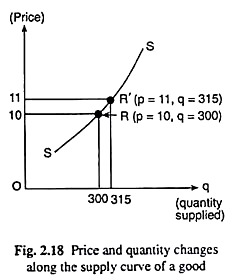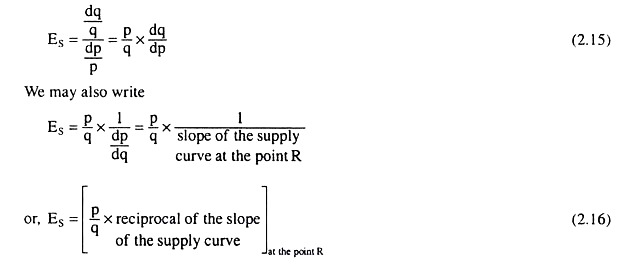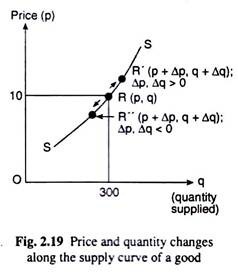In this article we will discuss about the definition, measurement and properties of the elasticity of supply.
Definition and Measurement of Elasticity of Supply:
If any of the determinants of the supply of a good changes, then the capacity of its supply to increase or decrease in response to this change, is known as the elasticity of supply w.r.t. the said change in the supply determinant.
some of the factors that might determine the supply of a good are mentioned. Of these factors, the most important is the price of the good. The capacity of the supply of a good to change in response to a change in its price is known as price-elasticity of supply. Here, by elasticity of supply shall mean the price-elasticity of supply.
The measure or coefficient (ES) of price-elasticity of supply can be obtained by means of the following formula:
In order to understand the significance of this formula, take the help of an example. Suppose that, initially, the price of a good (p) and the quantity supplied of it (q) are Rs 10 and 300 units respectively. This particular price-quantity combination is a point on the supply curve of the good. Suppose that this point is the point R on the supply curve SS of the good in Fig. 2.18.
Also suppose that as the price of the good increases from Rs 10 to Rs 11, its quantity supplied also increases from 300 units to 315 units. Here, the proportionate and percentage change in price are, respectively, 1/10 and 10 per cent, and the proportionate and percentage change in quantity supplied are, respectively, 15/300 and 5 percent.
Therefore, by the formula (2.14), the coefficient of price-elasticity of supply at the point R (p = 10, q = 300) would be
ES gives the p.c. change in quantity supplied in response to a 1 per cent change in price. In example above, ES = 1/2 gives that the supply would change by 1/2, per cent, if price changes by 1 per cent. It can express ES with the help of symbols in the following way.
Suppose that, initially, the price-quantity combination of the good is R(p, q), i.e., initially, the firm is at the point R (p, q) on the supply curve of the good in Fig. 2.19. Now suppose that the price of the good increases or decreases to p + dp (dp ≠ 0) and, consequently, quantity supplied increases or decreases to q + dq (dq ≠ 0). Therefore, at the point R (p, q) on the supply curve, It is obtained
Here (2.16) gives the relation between the slope of the supply curve and the coefficient of price-elasticity of supply (ES) at any point R (p, q) on the supply curve.
Properties of ES:
ADVERTISEMENTS:
(i) Owing to the law of supply, i.e., owing to the positive (or direct) relation between price and supply would obtain ES = positive.
(ii) ES gives the p.c. increase or decrease in the quantity supplied of the good if its price increases or decreases by 1 per cent. It is already noted.
(iii) It is evident from (2.14) that, if the p.c. change in supply is greater or smaller than the p.c. change in price, then, ES > 1, or, ES < 1 is obtained respectively. In the former case (ES > 1), supply of the good is relatively elastic and, in the latter case, (ES < 1) supply is relatively inelastic.
Now, if the p.c. change in the price of the good and the resulting p.c. change in supply are equal, then ES = 1 would be onbtained. In this case, the supply of the good is called unitary elastic.
(iv) Elasticity of supply at any particular point on the supply curve [e.g., at the point R (p, q) on the curve SS in Fig. 2.19], is called the point elasticity of supply. Rremember here that dp is an infinitesimally small change in p, which is known in calculus as a differential of p.



